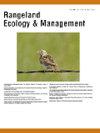高频、中分辨率卫星影像对入侵一年生草评估与监测的评价
IF 2.4
3区 环境科学与生态学
Q2 ECOLOGY
引用次数: 0
摘要
入侵的一年生草(IAGs)对牧场生态系统中的本地植物群落构成了前所未有的威胁,它们取代了本地植被,改变了火灾制度,影响了依赖本地多年生植物获得食物和住所的野生动物物种,并造成了巨大的经济代价。遥感可以通过多光谱图像监测IAGs,利用物候差异将入侵物种与本地植被区分开来。我们的研究目标是评估高频,中等分辨率多光谱行星图像和机器学习在检测IAG物种中的使用-特别是ventenata (ventenata dubia [Leers] Coss.), medusahead (Taeniatherum caput-medusae [L.]],草(Bromus tectorum L.)和日本雀麦(Bromus japonicus Thunb.)。我们的研究问题是:1)IAG物种分组是否影响远程检出率?2)高时空分辨率图像能否准确识别IAG对大规模除草剂施用的响应?在我们的入侵草地训练数据和分类模型和准确率指标中,Ventenata最具代表性。模型发现,即使在没有进行地面测绘的处理过的地方,用茚地氟仑(73 g·ai·ha - 1)空中处理的牧场和未处理的牧场中,IAG存在的可能性也存在差异。这表明有可能将这些入侵草预测模型扩展到类似混合草草原环境的地面映射训练区域之外,以提高IAG监测的效率。本文章由计算机程序翻译,如有差异,请以英文原文为准。
Evaluating High-Frequency, Moderate-Resolution Satellite Imagery for Assessment and Monitoring of Invasive Annual Grasses
Invasive annual grasses (IAGs) represent an unprecedented threat to native plant communities in rangeland ecosystems, displacing native vegetation, altering fire regimes, affecting wildlife species that depend on native perennials for food and shelter, and causing immense economic costs. Remote sensing allows the monitoring of IAGs through multispectral imagery, using phenological differences to separate invasive species from native vegetation. Our research goal was to evaluate the use of high-frequency, moderate-resolution multispectral Planet imagery and machine learning in detecting IAG species – specifically ventenata (Ventenata dubia [Leers] Coss.), medusahead (Taeniatherum caput-medusae [L.] Nevski), cheatgrass (Bromus tectorum L.), and Japanese brome (Bromus japonicus Thunb.). Our research questions were: 1) do IAG species groupings influence remote detection rates? and 2) can high spatio-temporal resolution imagery accurately identify IAG response to large-scale herbicide applications? Ventenata was best represented in our invasive grass training data and by classification models and accuracy indices. Models detected differences in IAG presence likelihood in pastures treated aerially with indaziflam at 73 g · ai · ha⁻1 and untreated pastures, even in treated locations where no ground mapping took place. This suggests the possibility of extending these invasive grass prediction models beyond ground-mapped training areas in similar mixed-grass prairie environments to increase the efficiency of IAG monitoring.
求助全文
通过发布文献求助,成功后即可免费获取论文全文。
去求助
来源期刊

Rangeland Ecology & Management
农林科学-环境科学
CiteScore
4.60
自引率
13.00%
发文量
87
审稿时长
12-24 weeks
期刊介绍:
Rangeland Ecology & Management publishes all topics-including ecology, management, socioeconomic and policy-pertaining to global rangelands. The journal''s mission is to inform academics, ecosystem managers and policy makers of science-based information to promote sound rangeland stewardship. Author submissions are published in five manuscript categories: original research papers, high-profile forum topics, concept syntheses, as well as research and technical notes.
Rangelands represent approximately 50% of the Earth''s land area and provision multiple ecosystem services for large human populations. This expansive and diverse land area functions as coupled human-ecological systems. Knowledge of both social and biophysical system components and their interactions represent the foundation for informed rangeland stewardship. Rangeland Ecology & Management uniquely integrates information from multiple system components to address current and pending challenges confronting global rangelands.
 求助内容:
求助内容: 应助结果提醒方式:
应助结果提醒方式:


